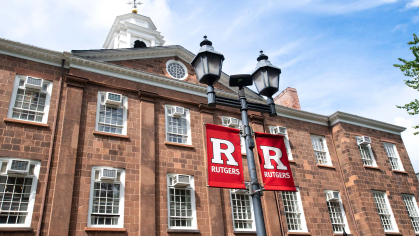Holloway Delivers Third Budget Address to University Senate
Rutgers University is making progress toward eliminating a deficit while developing a plan for financial sustainability and increasing revenues to support programs and improve operations, President Jonathan Holloway said in his third annual budget address to the University Senate.
In the past year, the university has successfully decreased by 30 percent a $125 million operating deficit through increased revenues and steps to control administrative costs, he said. A multiyear effort to reduce the deficit – resulting in part from inflation, shifts in enrollment, rising health care benefits costs and an end to COVID relief funds – continues as the university faces an uncertain state budget outlook.
The president’s annual address fulfills a promise he made to provide an update to the senate on the university’s finances during every spring semester. He told senate members that as individual units and departments have made difficult budget decisions, the university overall has been able to preserve programs while limiting dramatic cuts. In fact, an analysis of the number of graduate and undergraduate course sections being offered across Rutgers this spring is about 3.4 percent higher with an additional 358 sections than last spring.
The president said he remains hopeful that the university will continue to rebound, build back enrollment, and draw down its deficit to take on new investments for Rutgers’ teaching and research missions.
“Once we return to a balanced operating budget, we want to create an environment where we are generating additional net revenue to fund new initiatives, support a looming and increasing deferred maintenance backlog, and replenish reserves,” Holloway said.
Budget Basics
The university’s primary revenue sources continue to be tuition and fees, state appropriations, patient care services and sponsored research, Holloway noted. Funds from tuition and fees provide the largest sources of revenue while approximately 15 percent of revenue comes from other sources, including student housing and dining services, facility rentals, ticket sales, donor gifts and endowment income.

Rutgers’ priority spending funds its core missions: teaching, academic support, research, patient care and public service – all of which account for more than three-quarters of total operating expenses. Nearly 67 percent of the university’s annual operating budget supports faculty and staff compensation, including salary increases the university negotiated with several employee unions last year.
Other spending includes:
- 15 percent for building operations, maintenance and administration
- 5 percent for auxiliary enterprises, such as student housing and dining services
- 3 percent for athletics
Important Progress
Holloway cited several initiatives moving forward, including a few funded through external sources:
- Upgrades in more than 100 Rutgers buildings statewide through funding from PSE&G for work that will lower energy costs, reduce the university’s carbon footprint, and improve building system conditions
- A gradual conversion of the university vehicle fleet to electric vehicles, in line with the university’s Climate Action Plan, and five electric buses purchased for a Newark route
- 76 new faculty members hired through the faculty diversity hiring initiative, now at the midpoint of a $45 million, five-year investment
He also noted the university anticipates funding from the New Jersey Economic Development Authority and the National Institutes of Health for equipment and infrastructure upgrades to health care facilities on the Rutgers Health campus in Newark and for Rutgers Cancer Institute of New Jersey in New Brunswick.
Read President Holloway’s address to the University Senate.


